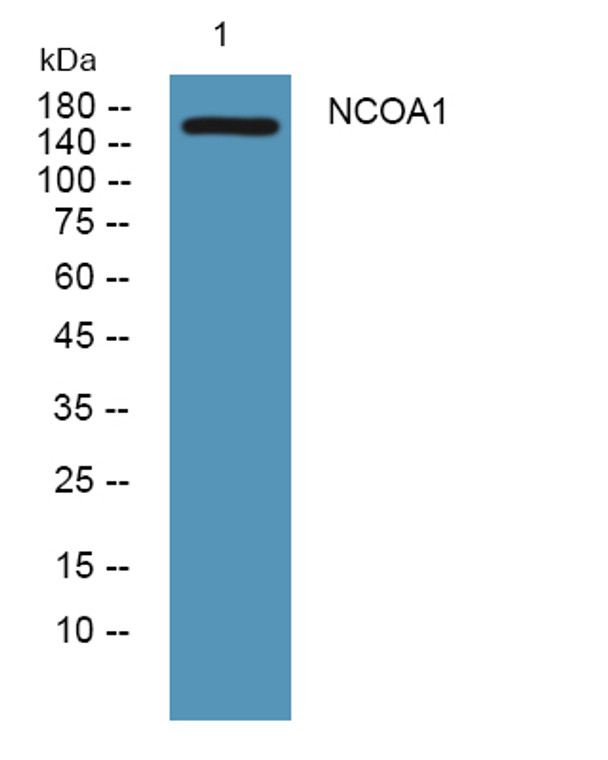| Host: |
Rabbit |
| Applications: |
WB/ELISA |
| Reactivity: |
Human/Mouse |
| Note: |
STRICTLY FOR FURTHER SCIENTIFIC RESEARCH USE ONLY (RUO). MUST NOT TO BE USED IN DIAGNOSTIC OR THERAPEUTIC APPLICATIONS. |
| Short Description: |
Rabbit polyclonal antibody anti-Nuclear receptor coactivator 1 (1120-1200 aa) is suitable for use in Western Blot and ELISA research applications. |
| Clonality: |
Polyclonal |
| Conjugation: |
Unconjugated |
| Isotype: |
IgG |
| Formulation: |
Liquid in PBS containing 50% Glycerol and 0.02% Sodium Azide. |
| Purification: |
The antibody was affinity-purified from rabbit antiserum by affinity-chromatography using epitope-specific immunogen. |
| Concentration: |
1 mg/mL |
| Dilution Range: |
WB 1:500-2000ELISA 1:5000-20000 |
| Storage Instruction: |
Store at-20°C for up to 1 year from the date of receipt, and avoid repeat freeze-thaw cycles. |
| Gene Symbol: |
NCOA1 |
| Gene ID: |
8648 |
| Uniprot ID: |
NCOA1_HUMAN |
| Immunogen Region: |
1120-1200 aa |
| Specificity: |
NCOA1 Polyclonal Antibody detects endogenous levels of protein. |
| Immunogen: |
Synthesized peptide derived from the human protein at the amino acid range 1120-1200 |
| Post Translational Modifications | Sumoylated.sumoylation increases its interaction with PGR and prolongs its retention in the nucleus. It does not prevent its ubiquitination and does not exert a clear effect on the stability of the protein. Ubiquitinated.leading to proteasome-mediated degradation. Ubiquitination and sumoylation take place at different sites. |
| Function | Nuclear receptor coactivator that directly binds nuclear receptors and stimulates the transcriptional activities in a hormone-dependent fashion. Involved in the coactivation of different nuclear receptors, such as for steroids (PGR, GR and ER), retinoids (RXRs), thyroid hormone (TRs) and prostanoids (PPARs). Also involved in coactivation mediated by STAT3, STAT5A, STAT5B and STAT6 transcription factors. Displays histone acetyltransferase activity toward H3 and H4.the relevance of such activity remains however unclear. Plays a central role in creating multisubunit coactivator complexes that act via remodeling of chromatin, and possibly acts by participating in both chromatin remodeling and recruitment of general transcription factors. Required with NCOA2 to control energy balance between white and brown adipose tissues. Required for mediating steroid hormone response. Isoform 2 has a higher thyroid hormone-dependent transactivation activity than isoform 1 and isoform 3. |
| Protein Name | Nuclear Receptor Coactivator 1Ncoa-1Class E Basic Helix-Loop-Helix Protein 74Bhlhe74Protein Hin-2Rip160Renal Carcinoma Antigen Ny-Ren-52Steroid Receptor Coactivator 1Src-1 |
| Database Links | Reactome: R-HSA-1368082Reactome: R-HSA-1368108Reactome: R-HSA-159418Reactome: R-HSA-192105Reactome: R-HSA-193368Reactome: R-HSA-193807Reactome: R-HSA-1989781Reactome: R-HSA-211976Reactome: R-HSA-2151201Reactome: R-HSA-2426168Reactome: R-HSA-3214847Reactome: R-HSA-381340Reactome: R-HSA-3899300Reactome: R-HSA-400206Reactome: R-HSA-400253Reactome: R-HSA-9018519Reactome: R-HSA-9029569Reactome: R-HSA-9623433Reactome: R-HSA-9707564Reactome: R-HSA-9707616 |
| Cellular Localisation | Nucleus |
| Alternative Antibody Names | Anti-Nuclear Receptor Coactivator 1 antibodyAnti-Ncoa-1 antibodyAnti-Class E Basic Helix-Loop-Helix Protein 74 antibodyAnti-Bhlhe74 antibodyAnti-Protein Hin-2 antibodyAnti-Rip160 antibodyAnti-Renal Carcinoma Antigen Ny-Ren-52 antibodyAnti-Steroid Receptor Coactivator 1 antibodyAnti-Src-1 antibodyAnti-NCOA1 antibodyAnti-BHLHE74 antibodyAnti-SRC1 antibody |
Information sourced from Uniprot.org
12 months for antibodies. 6 months for ELISA Kits. Please see website T&Cs for further guidance





